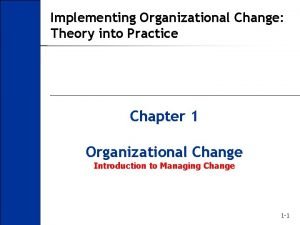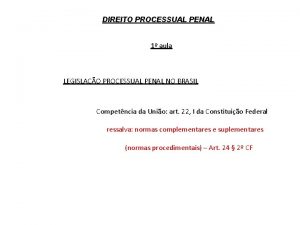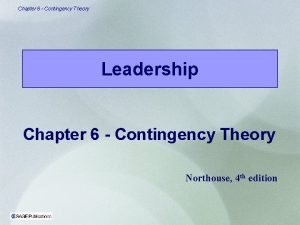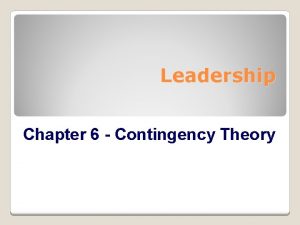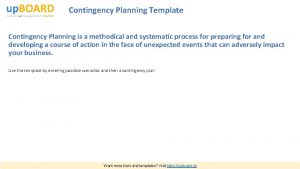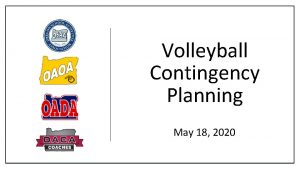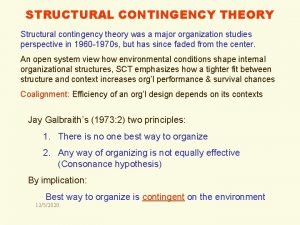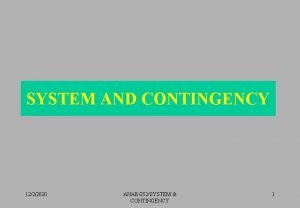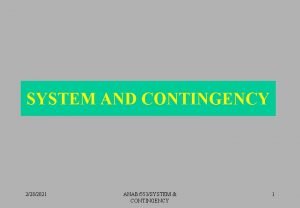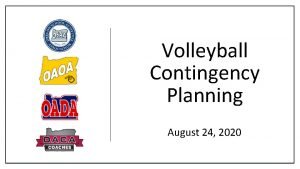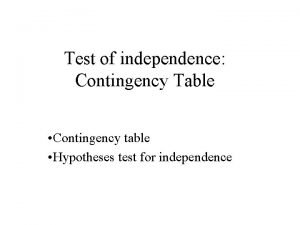Chapter 8 Implementing Change Change Management Contingency Processual

















- Slides: 17

Chapter 8 Implementing Change: Change Management, Contingency, & Processual Approaches Mc. Graw-Hill/Irwin Copyright © 2009 by The Mc. Graw-Hill Companies, Inc. All rights reserved.

Images of Managing Change Management Approach -Kotter’s Eight. Step Model -Other n-step models -N-step model issues Change Management vs Organization Development Contingency Approaches Processual Approach Image Rationale Chapter 7 Coach Organization Development Appreciative Inquiry Positive Organizational Scholarship These theories and approaches focus on identifying and building on what is working best in the organisation. Interpreter Sense-Making This approach as it alerts managers to the different influence that interpretations of change can have. Chapter 8 Director Change Management Contingency Theories They focus on strategic and planned organizational change. Intentional change outcomes can be achieved through a series of planned steps. There is certainty that it can be achieved. Navigator Processual Approach The outcomes are the result of a complex interplay of different interests, both internal and external to the organization. Note: The caretaker and nurturer images are not well addressed in the literature because as the assumption is that change managers receive rather than initiate change 8 -2

Change Management Approach Images of Managing Change Management Approach -Kotter’s Eight. Step Model -Other n-step models -N-step model issues Change Management vs Organization Development Contingency Approaches Processual Approach • Focuses on strategic, intentional and usually large-scale change • Entails following a variety of steps; the exact steps vary depending upon the model used • Belief that achieving organizational change is possible through a coordinated and planned approach • Very top-down 8 -3

Kotter’s Eight-Step Model Images of Managing Change Management Approach -Kotter’s Eight. Step Model -Other n-step models -N-step model issues Change Management vs Organization Development Contingency Approaches Processual Approach • Kotter’s eight-step model is one of the best known: 1. Establish the need for urgency 2. Ensure there is a powerful change group to guide the change 3. Develop a vision 4. Communicate the vision 5. Empower the staff 6. Ensure there are short-term wins 7. Consolidate gains 8. Embed the change in the culture 8 -4

Other N-Step Models Images of Managing Change Management Approach -Kotter’s Eight. Step Model -Other n-step models -N-step model issues Change Management vs Organization Development • • • Ten commandements (Kanter, Stein and Jick 1992) Ten Keys (Pendlebury, Grouard, and Meston 1998) 12 Action Steps (Nadler 1998) Transformation Trajectory (Taffinfer 1998) Nine-Phase Change Process Model (Anderson & Anderson 2001) Step-by-Step Change Model (Kirkpatrick 2001) 12 Step Framework (Mento, Jones and Dirndorfer 2002) RAND’s Six Steps (Light 2005) Integrated Model (Leppitt 2006) Contingency Approaches Processual Approach 8 -5

N-Step Model Issues Images of Managing Change Management Approach -Kotter’s Eight. Step Model -Other n-step models -N-step model issues Change Management vs Organization Development Contingency Approaches Processual Approach • • • The sequences of steps The number of steps The timing of steps The resourcing of steps The involvement in each step Difficult or easy? Managing multiple steps Revisiting different steps “Are all steps needed for particular changes? ” 8 -6

Change Management - Criticisms • • Reflective, rather than prospective Interpreted differently by different people Multiple changes may be happening “Commandments” need to be tailored to each organization Dialog must be both ways in reality The change may require experimentation, with no definite finish Strong leader may not be available Criticized as being more to pad CV of mgrs

Contingency Approaches Images of Managing Change Management Approach -Kotter’s Eight. Step Model -Other n-step models -N-step model issues Change Management vs Organization Development Contingency Approaches • Contingency approaches challenge the view that there is “one best way” • The style of change will vary, depending upon the scale of the change and the receptivity to change of organizational members. • In the Dunphy-Stace model the style of change varies from collaborative to coercive Processual Approach 8 -8

Dunphy/Stace (DS) • Scale of change and style of change management must be matched to the org

Dunphy/Stace (DS) • Developmental Transitions – Constant change due to evolving environment – Leader style is consultative – Gaining support for continuous improvement • Task-focused transitions – Change leader acts as captain – Seeking compliance in participation in change effort

Dunphy/Stace (DS) • Charismatic Transformation – People accept that org is “out of step” – Still need a leader to gain emotional buy-in • Turnaround – Coercive, frame-breaking – Change needs to be forced through • Taylorism – Paternalistic, fine tuning

Paths of Change • Orgs may adopt a different change approach at different times – Taylorism and charismatic transformation – Turnarounds and Task-focused transitions – Developmental Changes and Charismatic – Developmental/Task Focused and Charismatic/Turnaround changes

Huy • 4 categories of types of change – Commanding • Short term, abrupt, rapid • Senior executives demand compliance – Engineering • Medium-term, changing work systems • change mgr as systems analyst – Teaching • Long-term, teach staff how to recog change – Socializing • Long term, change develops through participative, democratic process

Criticisms - Contingency • Achieving “fit” may be difficult due to differing perceptions of the conditions in which the fit is sought • Contingency approaches require greater analysis and decisions by managers; the prescriptiveness of change management models may be attractive to managers • Contingency approaches focus on leadership style rather than a specific set of actions • The use of different change styles at different times may raises questions in the minds of staff as to the credibility of senior management. • There is a question about “what” is contingent to managing change 8 -14

Processual Approach • Draws on a navigator approach – Change seen as continuous, not linear – “no clear beginning, or end” • It sees the outcome of change as occurring through a complex interplay of different interest groups, goals, and politics. • This approach alerts the change manager to the range of influences which they will confront and the way in which these will lead to only certain change outcomes being achieved • This approach is often used to provide a detailed analysis and understanding of change retrospectively. 8 -15

Pettigrew • Questions that change can be accomplished with an n-step model • Time better spent gaining an understanding of the issues • Although proposes some stages – Problem sensing – and communicating – Development of concern about the problem – Acknowledgement of the problem – Planning and acting – Stabilizing change

Dawson • Simple linear “recipes” should be challenged • Change recipes need to be adapted due to the reactions and politics they create • Initiation of change recipes will “change” the environment in which change happens • Political processes impact speed of change
 Norma processual
Norma processual Princípios direito processual penal
Princípios direito processual penal Bert spector
Bert spector Implementing organizational change theory into practice
Implementing organizational change theory into practice Management issues central to strategy implementation
Management issues central to strategy implementation Implementing strategies management and operations issues
Implementing strategies management and operations issues Chapter 7 strategic management
Chapter 7 strategic management Setting prices and implementing revenue management
Setting prices and implementing revenue management Checklist model project management
Checklist model project management Matching structure with strategy
Matching structure with strategy Ch 7
Ch 7 Contingency reserve vs management reserve
Contingency reserve vs management reserve Implementation of hrd program
Implementation of hrd program Implementing merchandise plans
Implementing merchandise plans Designing and implementing branding strategies
Designing and implementing branding strategies Designing and implementing brand architecture
Designing and implementing brand architecture Principles of portfolio assessment
Principles of portfolio assessment Crm project plan
Crm project plan



